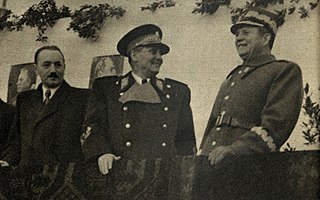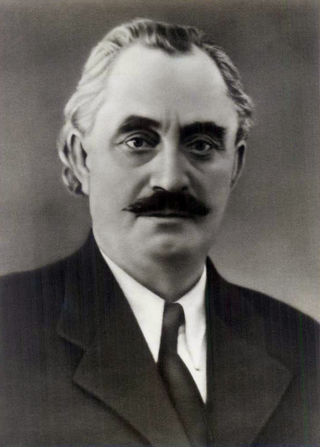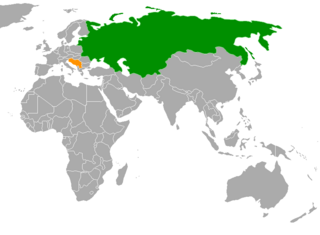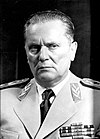
Josip Broz, commonly known as Tito, was a Yugoslav communist revolutionary and politician who served in various positions of national leadership from 1943 until his death in 1980. During World War II, he led the Yugoslav Partisans, often regarded as the most effective resistance movement in German-occupied Europe. Following Yugoslavia's liberation in 1945, he served as its prime minister from 1945 to 1963, and president from 1953 until his death in 1980. The political ideology and policies promulgated by Tito are known as Titoism.

The Socialist Federal Republic of Yugoslavia, commonly referred to as Socialist Yugoslavia or simply Yugoslavia, was a country in Central and Southeast Europe. It was established in 1945 as the Federal People's Republic of Yugoslavia, following World War II, and lasted until 1992, breaking up as a consequence of the Yugoslav Wars. Spanning an area of 255,804 square kilometres (98,766 sq mi) in the Balkans, Yugoslavia was bordered by the Adriatic Sea and Italy to the west, Austria and Hungary to the north, Bulgaria and Romania to the east, and Albania and Greece to the south. It was a one-party socialist state and federation governed by the League of Communists of Yugoslavia, and had six constituent republics: Bosnia and Herzegovina, Croatia, Macedonia, Montenegro, Serbia, and Slovenia. Within Serbia was the Yugoslav capital city of Belgrade as well as two autonomous Yugoslav provinces: Kosovo and Vojvodina.

Titoism is a socialist political philosophy most closely associated with Josip Broz Tito and refers to the ideology and policies of the League of Communists of Yugoslavia (LCY) during the Cold War. It is characterized by a broad Yugoslav identity, socialist workers' self-management, a political separation from the Soviet Union, and leadership in the Non-Aligned Movement.

Georgi Dimitrov Mihaylov also known as Georgiy Mihaylovich Dimitrov, was a Bulgarian communist politician who served as leader of the Bulgarian Communist Party from 1933 to 1949, and the first leader of the Communist People's Republic of Bulgaria from 1946 to 1949. From 1935 to 1943, he was the General Secretary of the Communist International.

The Informbiro period was an era of Yugoslavia's history following the Tito–Stalin split in mid-1948 that lasted until the country's partial rapprochement with the Soviet Union in 1955 with the signing of the Belgrade declaration. After World War II in Yugoslavia, Yugoslavia's new leadership under Josip Broz Tito pursued a foreign policy that did not align with the Eastern Bloc. Eventually, this led to public conflict, but the Yugoslav leadership decided not to acquiesce to Soviet demands, despite significant external and internal pressures. The period saw the persecution of the political opposition in Yugoslavia, resulting in thousands being imprisoned, exiled, or sent to forced labour. 100 Yugoslav citizens were seriously wounded or killed between 1948 and 1953 while some sources claim 400 victims during the existence of Goli otok prison camp. The purges included a significant number of members of Yugoslavia's security apparatus and its military.
The Anti-Fascist Council for the National Liberation of Yugoslavia, commonly abbreviated as the AVNOJ, was a deliberative and legislative body that was established in Bihać, Yugoslavia, in November 1942. It was established by Josip Broz Tito, the leader of the Yugoslav Partisans, an armed resistance movement led by the Communist Party of Yugoslavia to resist the Axis occupation of the country during World War II.

Milovan Djilas was a Yugoslav communist politician, theorist and author. He was a key figure in the Partisan movement during World War II, as well as in the post-war government. A self-identified democratic socialist, Djilas became one of the best-known and most prominent dissidents in Yugoslavia and all of Eastern Europe.

The League of Communists of Yugoslavia, known until 1952 as the Communist Party of Yugoslavia, was the founding and ruling party of SFR Yugoslavia. It was formed in 1919 as the main communist opposition party in the Kingdom of Serbs, Croats and Slovenes and after its initial successes in the elections, it was proscribed by the royal government and was at times harshly and violently suppressed. It remained an illegal underground group until World War II when, after the invasion of Yugoslavia in 1941, the military arm of the party, the Yugoslav Partisans, became embroiled in a bloody civil war and defeated the Axis powers and their local auxiliaries. After the liberation from foreign occupation in 1945, the party consolidated its power and established a one-party state, which existed in that form of government until 1990, a year prior to the start of the Yugoslav Wars and breakup of Yugoslavia.

Boris Kidrič was a Slovene and Yugoslav politician and revolutionary who was one of the chief organizers of the Slovene Partisans, the Slovene resistance against occupation by Nazi Germany and Fascist Italy after Operation Barbarossa in June 1941. He became the de facto leader of the Liberation Front of the Slovenian People. As such, he had a crucial role in the anti-Fascist liberation struggle in Slovenia between 1941 and 1945. After World War II he was, together with Edvard Kardelj, a leading Slovenian politician in communist Yugoslavia.

In late 19th and throughout the 20th century, the establishment of a Balkan Federation had been a recurrent suggestion of various political factions in the Balkans. The concept of a Balkan federation emerged in the late 19th century among left-wing political forces in the region. The central aim was to establish a new political unity: a common federal republic unifying the Balkan Peninsula on the basis of internationalism, socialism, social solidarity, and economic equality. The underlying vision was that, despite differences among the region's ethnic groups, the historical need for emancipation was a common basis for unification.

The State Anti-Fascist Council for the National Liberation of Croatia, commonly abbreviated ZAVNOH, was first convened on 13–14 June 1943 in Otočac and Plitvice as the chief political representative body in World War II Axis-occupied Croatia. It was dominated by the Communist Party of Croatia, a nominally-independent political party active in the territory largely corresponding to present-day Croatia. Despite its nominal independence, the party was a de facto branch of the Josip Broz Tito-led Communist Party of Yugoslavia. ZAVNOH also included representatives or former members of peasant organisations, trade unions, the Croatian Peasant Party, and the Independent Democratic Party.

Josip Kopinič was a Slovenian communist and close associate of Josip Broz Tito.

Andrija Hebrang was a Croatian and Yugoslav communist revolutionary and politician. A member of the Communist Party of Yugoslavia until his dismissal, he served as the 4th Secretary of the Central Committee of the Communist Party of Croatia.

Yugoslavism, Yugoslavdom, or Yugoslav nationalism is an ideology supporting the notion that the South Slavs, namely the Bosniaks, Bulgarians, Croats, Macedonians, Montenegrins, Serbs and Slovenes belong to a single Yugoslav nation separated by diverging historical circumstances, forms of speech, and religious divides. During the interwar period, Yugoslavism became predominant in, and then the official ideology of the Kingdom of Yugoslavia. There were two major forms of Yugoslavism in the period: the regime favoured integral Yugoslavism promoting unitarism, centralisation, and unification of the country's ethnic groups into a single Yugoslav nation, by coercion if necessary. The approach was also applied to languages spoken in the Kingdom. The main alternative was federalist Yugoslavism which advocated the autonomy of the historical lands in the form of a federation and gradual unification without outside pressure. Both agreed on the concept of National Oneness developed as an expression of the strategic alliance of South Slavs in Austria-Hungary in the early 20th century. The concept was meant as a notion that the South Slavs belong to a single "race", were of "one blood", and had shared language. It was considered neutral regarding the choice of centralism or federalism.

The Information Bureau of the Communist and Workers' Parties, commonly known as Cominform (Коминформ), was a co-ordination body of Marxist–Leninist communist parties in Europe which existed from 1947 to 1956. Formed in the wake of the dissolution of the Communist International in 1943, it did not replace that body, but instead mainly served as an expression of solidarity and as a means of disseminating Stalinist propaganda. The Cominform initially included the communist parties of the Soviet Union, Bulgaria, Czechoslovakia, Hungary, Poland, Romania, Yugoslavia, France, and Italy. The organization was dissolved in 1956, during de-Stalinization.

Mustafa Golubić was a Serbian, and later Yugoslav, guerrilla fighter, revolutionary and intelligence agent.

The Communist Party of Yugoslavia (CPY) convened the supreme body for its 6th Congress in Zagreb on 2–7 November 1952. It was attended by 2,022 delegates representing 779,382 party members. The 6th Congress sought to discuss new policies, first of all in reaction to the Yugoslav–Soviet split and Yugoslav rapprochement with the United States. The congress is considered the peak of liberalisation of Yugoslav political life in the 1950s. The Congress also renamed the party the League of Communists of Yugoslavia.
The Croatian Republican Peasant Party was a political party formed from a faction split from the Croatian Peasant Party in 1941. The HSS was once the most popular political party among the Croats in the Kingdom of Yugoslavia, but after the Axis invasion of Yugoslavia, the HSS splintered in several groups including the faction that would become the HRSS. It joined the Yugoslav resistance led and dominated by the Communist Party of Yugoslavia (KPJ) and by its branch in Croatia – the Communist Party of Croatia (KPH). The prewar leader of the HSS Vladko Maček opted to wait for the war to end, while another faction joined the Ustaše movement that ruled the Axis puppet Independent State of Croatia (NDH).

During World War II, the Croatian Peasant Party splintered into several factions pursuing different policies and alliances. Prior to the German invasion of Yugoslavia, it was the most powerful political party among ethnic Croats, controlled the administration and police in Banovina of Croatia, and commanded two paramilitary organisations. After the successful invasion of the Kingdom of Yugoslavia in April 1941, Nazi Germany proposed that HSS leader Vladko Maček could rule Croatia as a puppet state. He declined, but the Ustaše agreed and proclaimed the Independent State of Croatia. Under duress, Maček called on Croats to support the regime. A splinter of the HSS and all HSS-controlled infrastructure went over to the Ustaše.

Soviet Union–Yugoslavia relations were historical foreign relations between Soviet Union and Yugoslavia. Both states became defunct with the dissolution of the Soviet Union between 1988 and 1991 and the breakup of Yugoslavia between 1991 and 1992. Relations between the two countries developed very ambiguously. Until 1940 they were openly hostile, in 1948 they deteriorated again and in 1949 were completely broken. In 1953–1955 period, bilateral relations were restored with the signing of Belgrade declaration, but until the collapse of Yugoslavia they remained very restrained. Relations with Soviet Union were of high priority for Belgrade as those relations or their absence helped the country to develop the principle of Cold War equal-distance on which the Yugoslav non-alignment policy was based.




























